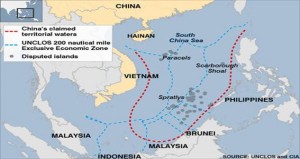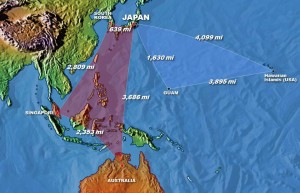2013-01-17 by Robbin Laird
The 21st century is not the 20th. But this is too often forgotten when it comes to shaping an effective military and security strategy.

First, the rise of China is clear both in terms of its impacts and disruptions.
Second, the US has limited power projection capability to deliver into the Pacific.
Third, the rise of the Arctic has changed the scope of the landscape upon which one needs to shape a strategy.
Fourth, key allies in the Pacific will determine the effectiveness of any US strategy in the region.
Any US-China rivalry in the Pacific really revolves around who has the most effective allied strategy, and whether or not the US delivers what allies are looking for, which is American presence, engagement and effective capabilities to assist in the deterrence of China and the deflection of Chinese efforts to dominate in the region and beyond.
The allies are always forward deployed and when joined with an enduring presence mission for the US projection forces, a powerful foundation for scalability of US and allied forces is provided. And with the United States providing strategic depth reachback to an integrated and networked force is inherently possible.
Presence, scalability and reach back are solid foundations for the kind of deterrence necessary in the evolving strategic environment in the Pacific.
The challenge for the US is to shape approaches and systems, which can plug into what allies themselves are doing. In effect, the US needs to shape a lynchpin strategy, which enables allies, the maneuver space to deal with China.
We have interviewed many leaders and analysts in the Pacific to determine what the evolving orientations below the surface are in dealing with the new Pacific dynamics, China, maritime and trade security and the Arctic, among others.
Certainly, a key point is that the Chinese are the made trading partner and the main threat to the power position of many of our allies. Shaping a strategy that can deal with both realities is a sine qua non for success in the region, both for our allies and us.
In the next piece, I will deal with South Korean defense because it is so crucial to how the US could re-shape its Pacific engagement and presence strategy. For now, I am going to deal with three key allies: Japan, Singapore and Australia.
The Dynamic Defense of Japan
Earlier this year, the Japanese government released its latest Defense White Paper.
This is the first white paper released since they announced their decision to acquire the F-35, and provides a further elucidation upon the new defense policy announced in 2010.
The Japanese announced in that year, that they were shifting from a static island defense, which rested upon mobilization, to a “dynamic defense” which required more agile forces able to operate in the air and maritime regions bordering Japan.
Notably, the Japanese recognized the need for these “dynamic defense” forces to be interoperable with allies to provide for the kind of defense Japan and the allies needed in light of changing dynamics in the region.
As the White Paper puts it:
It is necessary that Japan’s future defense force acquire dynamism to proactively perform various types of operations in order to effectively fulfill the given roles of the defense force without basing on the “Basic Defense Force Concept” that place priority on “the existence of the defense force.”
To this end, the 2010 NDPG calls for the development of “Dynamic Defense Force” that has readiness, mobility, flexibility, sustainability, and versatility, and is reinforced by advanced technology based on the latest trends in the levels of military technology and intelligence capabilities. The concept of this “Dynamic Defense Force” focuses on fulfilling the roles of the defense force through SDF operations.
It is obvious that changes in the neighborhood require Japan to adopt such a policy.
The North Koreans have built and deployed a nuclear tipped missile force, which clearly threatens Japan. And the Chinese are shaping power projection forces to provide for an increasingly capable force able to operate in the maritime and air space affecting Japanese security.
The Chinese game in this regard is especially important to recognize.

Although the Chinese leadership has made their intentions quite clear about expanding their military capabilities and regional and global reach, Western powers continue to call for increased “transparency” with regard to Chinese intentions.
“Transparency” is nice, but capabilities to counter any misperceptions by the Chinese are better. And the Japanese White Paper is clear on both. It is important to Japan to work with allies and to work with the Chinese in shaping a more effective and more stable security situation in the neighborhood.
Nonetheless, wishful thinking is just that.
Or apparently, they did not require a J-20 flying over the head of their Defense Minister to get this point.
Again according to the White Paper:
Defense capabilities are Japan’s ultimate guarantee for security, expressing the will and capacity of Japan to defend against foreign invasions. In this way, the function of defense capabilities cannot be substituted by any other method. For this reason, defense capabilities are vital for ensuring an appropriate response to various contingencies arising from the security challenges and destabilizing factors, which are diverse, complex, and intertwined….
Singapore and Shaping an IKC2 Force
The intersection of the defense of Japan, South Korea, Australia and Singapore forms a quadrangle of defense interests in providing for the security of key US allies in the region. The US is directly or indirectly involved in the defense of all key allies in the Quadrangle, and the evolution of their capabilities individually and collectively is crucial to the evolution of American capabilities and strategy in the decade ahead.
Singapore is a non-aligned power with close ties to the United States politically and militarily and close ties with China economically and politically. They depend on the security of maritime trade and the safety and security of the global commons.
They have built a modern naval and air force and are investing in its further modernization. And their efforts are founded on working with Western countries and firms in shaping an effective modernization strategy. And they are seeking to ensure that the force is well integrated and networked. Their concept for doing so is called an Integrated Knowledge Command and Control Concept, which is their version of the Revolution in Military Affairs (RMA).
This concept is well articulated on Singapore’s Ministry of Defense website as follows:
On the ground and in the jungles, the SAF will transform into a lean, networked and lethal fighting force while staying focused on the new security challenges. It will employ new technologies, such as precision fire, advanced communications and information technology, as well as unmanned vehicles, to defeat potential adversaries. At the same time, innovative warfighting concepts in combined arms operations, urban fighting and infantry fieldcraft will be introduced in tandem to provide the SAF with the operational edge.
Out at sea, the SAF will achieve potent three-dimensional fighting capabilities in the air, on the surface, and under the sea. Its ships will also have the command and control capability to conduct seamless operations as an integrated force with aircraft and land forces, through effective use of advanced communications and information technology, while leveraging on platform strengths. The SAF should thus be ready to meet the full spectrum of maritime threats, including small, fast-moving boats in the littorals that can otherwise pose a tremendous challenge to traditional naval forces.
In the air, the SAF will achieve Air Dominance through the coordinated employment of fighters, unmanned air vehicles and airborne surveillance aircraft, which are integrated through real-time knowledge-based systems and networks. The networked force will have comprehensive situational awareness that gives the critical edge in air operations. The SAF will also marry advanced surveillance and strike capabilities over surface threats, including elusive targets that may be concealed under foliage or ships out on open sea.
Finally, tying all these air, land and sea capabilities together into a synergistic whole is the concept of Integrated Knowledge-based Command and Control (IKC2). The concept gives commanders and soldiers the ability to see first, see more; understand better; decide faster; so that they can act decisively to achieve victory. This is achieved by leveraging on networks of sensors, shooters and communications to provide comprehensive awareness and self-synchronization on the battlefield. The networks also provide wells of information, which will also be translated into relevant knowledge for superior decision-making to achieve precise effects, and effectively shape the battlefield.

Shaping as integrated a force as possible is central to Singapore to deal with a wide-range of defense and security needs. And they are doing so in the face of the rise of China.
According to Singapore based strategic analyst, Richard Bitzinger:
Singapore is non-aligned. But it operates closely with the United States and allies in the region. They buy Western equipment, provide a leasing arrangement for the US navy to operate in Singapore and train in several allied facilities in the region. They train for tank warfare in Australia, they train for jungle warfare in Brunei, they do infantry training in Taiwan, fighter training in the U.S. and have a working relationship for training in France.
At the same time, they have close economic and political ties with China. A balancing act is central to Singapore’s security policies in the region.
There has been a clear shift in the past few years. Prior to this period, the main focus of military modernization for Singapore has been upon dynamics in Southeast Asia, and preparing for threats from countries like Malaysia and Indonesia. Now this concern is being superseded by the perceived need to deal with the military rise of China.
But Bitzinger cautions that the pivot to the Pacific has not lived up to its requirements.
To date, allies in the region are disappointed about what they see as the realities of more rhetoric than reality in US policy. But make no mistake. The allies in the region cannot counter China by themselves, and are looking to the United States to play a key role in this effort.
https://sldinfo.com/singapore-faces-the-future-shaping-a-ikc2-defense-force/
Re-shaping Australian Defense
The Australian government has recognized the need to re-shape defense capabilities to deal with new Pacific realities.
The 2009 White Paper projected a significant augmentation of Australian ability to play a significant role in Australian and in regional and global defense operations in partnership with their allies, primarily the United States.
Australia envisages new platforms to its forces, such as the just recently received 5th new Airbus Military tanker. Australia has developed some very interesting capabilities such as a new radar system on its frigates, which combine indigenous development with working arrangements with US companies.
The HMAS Perth participated in the recent RIMPAC 2012 exercise and demonstrated its new AESA capabilities at sea in extremely high sea states. This type of commitment is a key part of shaping 21st century Australian capabilities.
Two challenges are facing the Aussies as they shape the future.
First, there are funding challenges but their funding challenge is a reluctance to spend a surplus. Such reluctance may well shape an inability of Australia to defend itself if taken to extremes.
As the well respected Aussie analyst, Air Vice-Marshal (Ret.) John Blackburn, now the Chairman of the influential Australian think tank, the Kokoda Foundation, underscored in a recent interview:
Unfortunately, the Defense Plan has not been fully funded.
With the scale of deferral of funding and the reductions announced in the 2012 defense budget, Australians are now spending a smaller percentage of our GDP on defense that at any time in past 20 years. Having said that, we are still spending considerable sums on defense in comparison to our regional neighbors, but not enough to implement the ambitious 2009 plan.
But the other challenge is very relevant to what kind of leadership the US brings to the party. If the US goes down the platform centric acquisition route, we will run out of capability more rapidly than we run out of capability.
An alternative approach is evident in the Aussie case – the need to build a more integrated force, perhaps along the lines envisaged by Singapore.
Blackburn added:
You have written that no platform fights alone. That is an essential key to get through to the wider public audience and to our political leaders.
Buying the F-35 is a crucial piece of the puzzle, but understanding that the aircraft is an enabler of the network or the honeycomb is essential to shaping the total design of our Defense Forces.
We need to help people understand that an effective force is not the platforms by themselves, but the effectiveness of the platforms as a part of a larger networked or “honeycombed” force. Such a force will not be just Australian or American – it will be an alliance force enable by a common grid framework … if we design it as such.
Conclusion
In short, the US and its allies face a fluid situation in the Pacific. But Chinese intentions are not abstract or unknown. Their recent e-passport policy whereby they assert their claims to territory in Asia as a cost of entering the country could not be clearer.
As the well-known global analyst DK Matai has warned:
As China’s military and economic influence has grown throughout the world, Beijing appears to have become bolder, brasher and more brazen in its claim to territories believed to be rich with oil and natural gas across the Asia-Pacific.
The latest attempt to achieve just that is the watermark on China’s new e-passports depicting its map, which has ended up insulting and offending most of its sovereign neighbors.
https://sldinfo.com/china-and-its-policies-towards-energy-rich-territories-in-asia-pacific/
The challenge is how to deal with your leading trade partner while deterring them as your major pressure power in the region and beyond.
Our allies are shaping their approaches accordingly and we need to find ways for successful convergence in countering the Chinese power game.
This article first appeared on AOL Defense
http://defense.aol.com/2013/01/15/partners-in-the-pacific-singapore-australia-and-japan/

